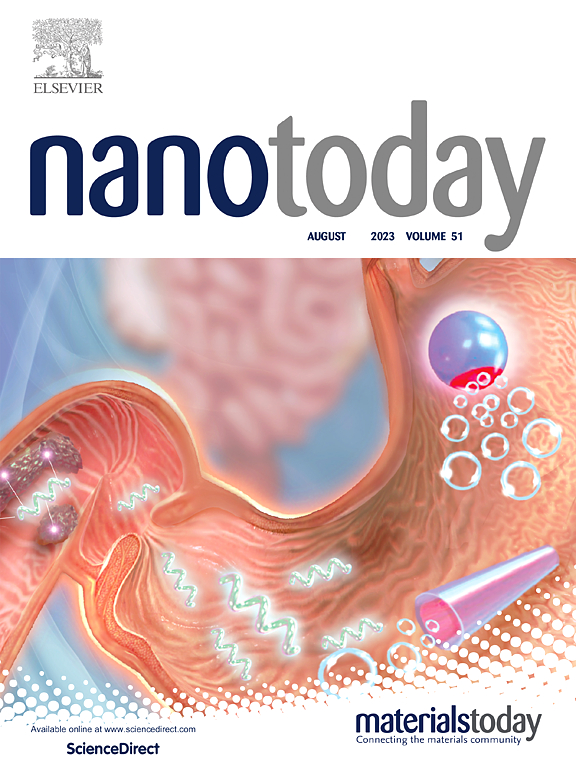Real-time ROS monitoring-guided tumor electrodynamic therapy using a metal microneedle array system
IF 13.2
1区 材料科学
Q1 CHEMISTRY, MULTIDISCIPLINARY
引用次数: 0
Abstract
Currently, various strategies are employed to utilize reactive oxygen species (ROS) amplifiers in tumor therapy; Electrodynamic therapy (EDT) presents a promising modality for ROS amplification, as it can continuously produce substantial quantities of ROS independent of endogenous sources, thereby demonstrating potential antitumor activity. Nonetheless, achieving prolonged tumor suppression with EDT remains a significant challenge. Conventional EDT approaches frequently encounter issues with inadequate overlap between the active electric field region and the drug distribution area, resulting in insufficient electrocatalytic action and uneven ROS distribution. Furthermore, individual physiological variability can lead to disparate therapeutic outcomes from identical drug dosages, and indiscriminate increases in ROS dosage may inadvertently exacerbate tumor invasion and metastasis. To address these challenges, we developed a microneedle (MN) array system that combines ROS sensing and enables precise EDT therapy. The integrated system offers multifunctional capabilities, including drug delivery, electrical stimulation, and real-time ROS sensing. Benefiting from the homogeneously distributed electric field provided by the MN array, we significantly enhanced the electrocatalytic performance of electrodynamic nanomedicines. The integrated system produces cell-toxic ROS at 2.4 times the rate of traditional methods and induces tumor cell apoptosis 2.6 times more effectively. Real-time ROS monitoring via sensing electrodes allows precise drug dosage adjustments, ensuring effective ROS amplification therapy while minimizing waste. Adding DON further boosts ROS accumulation and strengthens anti-tumor immunity. The miniaturized dual-power supply strategy, combining a constant current source with ROS signal collection, enhances clinical suitability, optimizing both therapeutic efficacy and precision in tumor treatment.
金属微针阵列系统实时ROS监测引导肿瘤电动力治疗
目前,利用活性氧(ROS)放大器进行肿瘤治疗的策略多种多样;电动力疗法(EDT)是一种很有前途的ROS扩增方式,因为它可以不依赖内源性来源而持续产生大量的ROS,从而显示出潜在的抗肿瘤活性。然而,通过EDT实现长期的肿瘤抑制仍然是一个重大挑战。传统的EDT方法经常遇到活性电场区域与药物分布区域重叠不足的问题,导致电催化作用不足,ROS分布不均匀。此外,个体生理差异可能导致相同药物剂量的不同治疗结果,并且不加区分地增加ROS剂量可能无意中加剧肿瘤的侵袭和转移。为了解决这些挑战,我们开发了一种结合ROS传感和精确EDT治疗的微针(MN)阵列系统。该集成系统具有多种功能,包括药物输送、电刺激和实时ROS传感。利用锰阵列提供的均匀分布的电场,我们显著提高了电动力纳米药物的电催化性能。该综合系统产生细胞毒性ROS的效率是传统方法的2.4倍,诱导肿瘤细胞凋亡的效率是传统方法的2.6倍。通过传感电极实时监测ROS,可以精确调整药物剂量,确保有效的ROS扩增治疗,同时最大限度地减少浪费。添加DON进一步促进ROS积累,增强抗肿瘤免疫。小型化双电源策略,将恒流源与ROS信号采集相结合,提高了临床适用性,优化了肿瘤治疗的疗效和精度。
本文章由计算机程序翻译,如有差异,请以英文原文为准。
求助全文
约1分钟内获得全文
求助全文
来源期刊

Nano Today
工程技术-材料科学:综合
CiteScore
21.50
自引率
3.40%
发文量
305
审稿时长
40 days
期刊介绍:
Nano Today is a journal dedicated to publishing influential and innovative work in the field of nanoscience and technology. It covers a wide range of subject areas including biomaterials, materials chemistry, materials science, chemistry, bioengineering, biochemistry, genetics and molecular biology, engineering, and nanotechnology. The journal considers articles that inform readers about the latest research, breakthroughs, and topical issues in these fields. It provides comprehensive coverage through a mixture of peer-reviewed articles, research news, and information on key developments. Nano Today is abstracted and indexed in Science Citation Index, Ei Compendex, Embase, Scopus, and INSPEC.
 求助内容:
求助内容: 应助结果提醒方式:
应助结果提醒方式:


